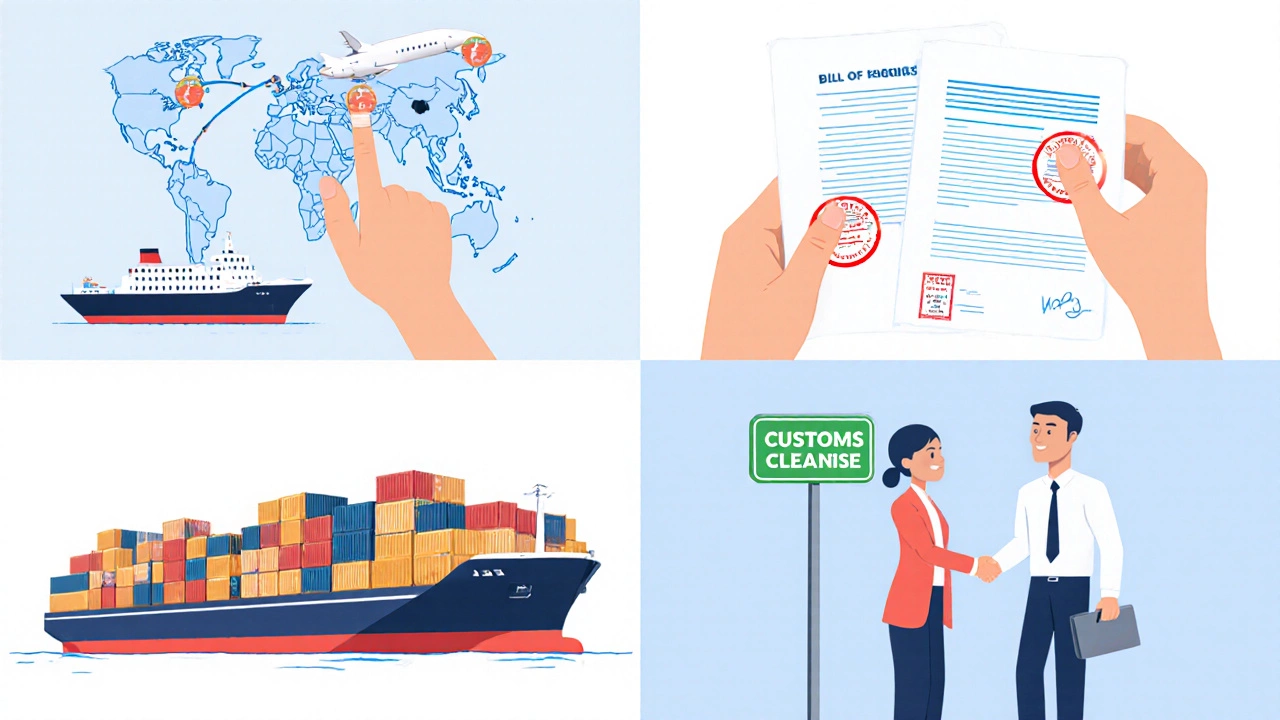International Freight Cost Estimator
Key Takeaways
- A freight forwarder is the middle‑person who plans, arranges, and monitors shipments across borders.
- They handle paperwork, negotiate rates, and ensure cargo meets customs rules.
- Working with a forwarder can lower cost, shorten transit time, and reduce risk.
- Choosing the right partner means checking experience, network, technology, and compliance support.
What a Freight Forwarder Actually Is
When you ship goods internationally, a Freight Forwarder is a professional who coordinates the movement of cargo from origin to destination, handling paperwork, transport modes, and compliance.
In short, a freight forwarder acts as your logistics partner, turning a complex maze of regulations, carriers, and schedules into a single, manageable process.
Core Responsibilities
Freight forwarders wear many hats. Their day‑to‑day tasks fall into four main buckets:
- Route planning and carrier selection - they compare sea, air, rail and road options, picking the most cost‑effective and reliable combo.
- Documentation and compliance - they prepare the Bill of Lading, commercial invoices, and any licences required for export or import.
- Freight consolidation and packing advice - they group smaller shipments together (a practice known as freight consolidation) to fill container space and cut costs.
- Customs clearance support - they work with customs brokers to make sure duties, taxes, and inspections are handled correctly.
How They Add Value to Your Supply Chain
Imagine trying to negotiate rates with dozens of carriers yourself. You'd waste time, risk missing deadlines, and likely pay more. A freight forwarder brings three clear advantages:
- Network leverage: Because they ship on behalf of many clients, forwarders secure volume discounts that are unavailable to single exporters.
- Risk mitigation: They stay up‑to‑date on trade regulations, reducing the chance of customs holds, fines, or cargo loss.
- Visibility tools: Modern forwarders offer online tracking dashboards that let you see shipment status in real time.

The End‑to‑End Freight Forwarding Process
Below is a typical workflow, broken down into nine clear steps.
- Quote request - you send product details, weight, dimensions, and destination.
- Rate comparison - the forwarder pulls rates from carriers, adds handling fees, and presents you a quote.
- Booking - once you approve, they reserve space on a ship, plane, or truck.
- Documentation preparation - they generate a Bill of Lading, commercial invoice, packing list, and any required certificates.
- Cargo pick‑up - an inland carrier collects the goods from your warehouse and brings them to the departure terminal.
- Customs clearance (export) - the forwarder files export declarations with the relevant authority.
- Transit - the cargo moves via sea, air, rail, or road. Tracking data is pushed to your portal.
- Customs clearance (import) - at the destination, the forwarder works with a customs broker to pay duties and release the cargo.
- Final delivery - a local carrier drops the shipment at your buyer’s door or at a warehouse for you to collect.
Key Documents You’ll Encounter
Understanding the paperwork helps you avoid surprise delays.
- Bill of Lading - the contract between shipper and carrier; it proves ownership of the cargo.
- Commercial invoice - details the buyer, seller, value, and description of goods; customs uses it to assess duties.
- Packing list - itemizes each crate, pallet, or box; essential for inspection and warehouse handling.
- Certificate of origin - verifies where the goods were made; required for preferential tariff programs.
- Import/export licences - some products (e.g., chemicals, electronics) need government permission.
Modes of Transport a Forwarder Manages
Freight forwarders are multi‑modal specialists. Here’s a quick snapshot of each mode’s strengths:
| Transport Mode | Typical Lead Time | Cost per KG | Best For |
|---|---|---|---|
| Sea (Full Container Load) | 30‑45 days | Low | Large, non‑time‑critical shipments |
| Air Cargo | 1‑5 days | High | High‑value, perishable, or urgent goods |
| Rail | 7‑15 days | Medium | Inland Europe, land‑locked destinations |
| Road (Truck) | 2‑7 days | Medium‑High | Last‑mile delivery and regional trade |
What to Look for When Choosing a Freight Forwarder
Not every forwarder is created equal. Use the following checklist to narrow down the best fit for your business.
- Experience in your market - a forwarder that ships to your target countries daily will know local regulations better.
- Technology platform - real‑time tracking, automated document uploads, and API integration cut manual effort.
- Network of partners - access to reputable carriers, customs brokers, and warehousing agents.
- Transparent pricing - clear breakdown of freight cost, handling fees, and any surcharges.
- Insurance options - ability to arrange cargo insurance for high‑value items.
- Customer service responsiveness - 24/7 support is crucial when delays occur.
Ask for references, check their compliance record, and request a pilot shipment before committing to a long‑term contract.
Common Misconceptions About Freight Forwarding
Many businesses think a forwarder is just a “shipping agent". In reality, they act as an extension of your supply‑chain team.
- Misconception: "I can handle customs myself." Reality: Customs rules change weekly; a forwarder’s partnership with licensed brokers prevents costly holds.
- Misconception: "Forwarders are only for big companies." Reality: Small exporters benefit from freight consolidation and volume discounts that a forwarder aggregates.
- Misconception: "All forwarders charge the same." Reality: Service quality, technology, and network depth create wide price variations.
Future Trends Shaping Freight Forwarding
Technology isn’t standing still. Here are three trends you’ll see in the next few years:
- Digital twins of supply chains - forwarders will simulate routes in real time to avoid congestion.
- Blockchain documentation - immutable records for provenance, especially in high‑risk goods.
- Sustainable freight options - carbon‑neutral containers and AI‑driven load optimization to cut emissions.
Partnering with a forwarder that invests in these tools keeps you ahead of the curve.
Frequently Asked Questions
What is the difference between a freight forwarder and a customs broker?
A freight forwarder arranges the whole transport journey - carrier selection, packing advice, and documentation. A customs broker focuses solely on clearing goods through customs, handling duties, taxes, and regulatory compliance.
Do I need a freight forwarder for domestic shipments?
If your shipment stays within one country and you have simple carrier contracts, you may not need a forwarder. However, for multi‑modal or time‑critical moves, a forwarder can still add value through consolidation and tracking.
How are freight forwarder fees structured?
Most forwarders charge a flat handling fee plus a margin on carrier rates. Some offer a cost‑plus model, while others provide all‑in‑one quotes that include insurance, documentation, and customs assistance.
Can a freight forwarder help with hazardous material shipments?
Yes. Forwarders experienced in dangerous goods will arrange proper classification, packing, labeling, and obtain the necessary permits to keep the shipment compliant.
What should I ask a potential forwarder before signing?
Ask about their carrier network, technology platform, average transit times for your routes, insurance options, and how they handle customs issues. Request references from customers in the same industry.


